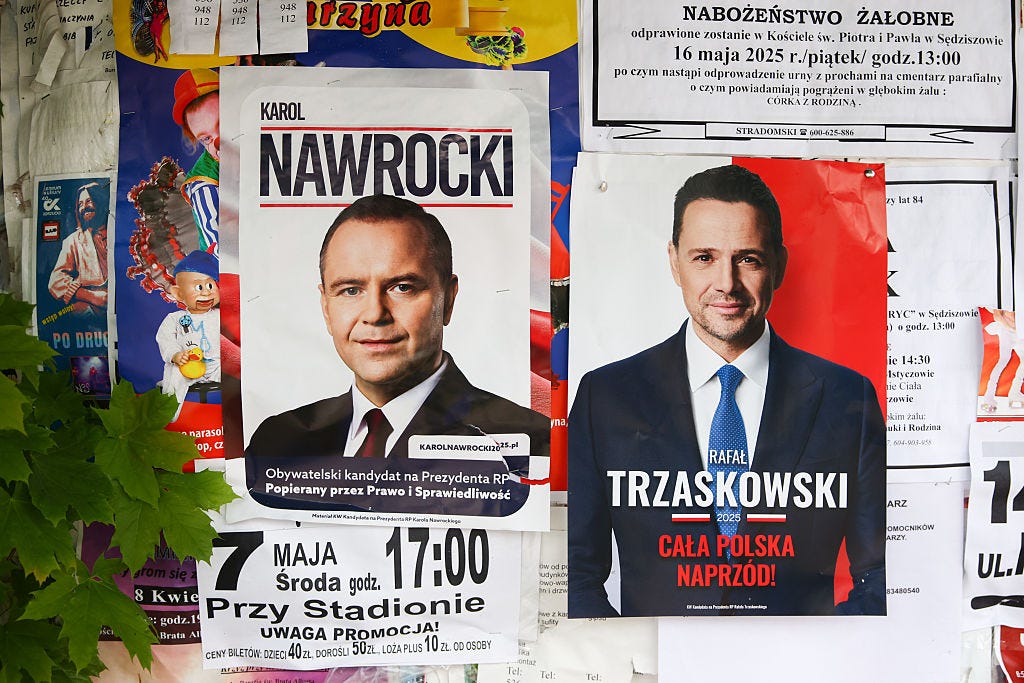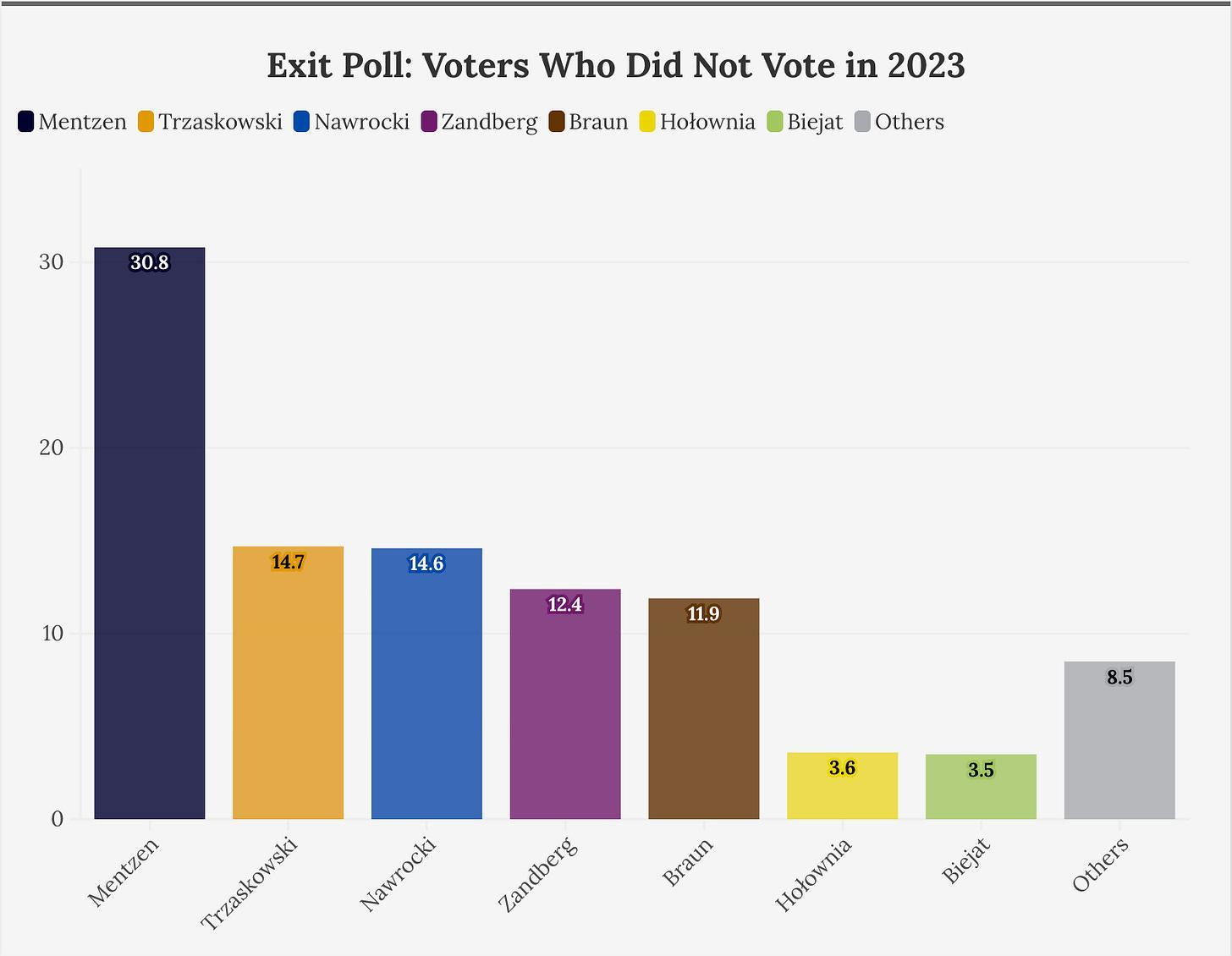Don’t Celebrate Poland’s Results Yet
The first round suggests the liberal mainstream is in trouble.
This article is brought to you by American Purpose, the magazine and community founded by Francis Fukuyama in 2020, which is proudly part of the Persuasion family.
The first round of Poland’s presidential election has handed liberals a Pyrrhic victory. The leading centrist candidate, Civic Coalition’s Rafał Trzaskowski, narrowly emerged at the top of a field of thirteen. Yet he now faces a difficult June 1 runoff against second-place Karol Nawrocki, a conservative backed by the right-wing populists of Law and Justice (PiS) who ruled Poland from 2015 to 2023. Signs are flashing red for Trzaskowski: hard-right libertarian Sławomir Mentzen won a strong third place with 15% of the vote, and many of his voters may opt for Nawrocki in round two. The even-further-right Grzegorz Braun (who made headlines in 2023 for using a fire extinguisher to douse a menorah in Poland’s parliament) beat predictions to place fourth. Polls show the runoff will be close, but Trzaskowski’s first-round win masks the fact that momentum is with the right.
If Nawrocki is elected president, Poland’s government may collapse. Prime Minister Donald Tusk has led a three-party coalition of his centrist Civic Coalition, the conservative “Third Way” faction, and the Left party since December 2023. Poland’s system gives most power to parliament, which elects the prime minister, but the president, chosen separately, can veto laws and hamper government initiatives. Key reforms proposed by Tusk’s government have been blocked by incumbent president Andrzej Duda, who was elected with the support of PiS in 2015 and was reelected over Trzaskowski in 2020. Tusk’s coalition has banked on a Trzaskowski win to enable legislative accomplishments and provide new energy. Nawrocki’s election would worsen gridlock and call the coalition’s continued purpose into question.
The results of the first round also betray deeper challenges for Polish liberals. Exit polls and preliminary results suggest three phenomena that underline the daunting task before Trzaskowski and Poland’s liberal mainstream.
1) The ideological breadth of Poland’s liberal camp has proven more of a weakness than a strength. In the 2023 parliamentary elections, it was seen as a strategic triumph that voters dissatisfied with Law and Justice had three distinct options to choose from. The Left, Third Way, and Civic Coalition were all clearly anti-PiS, but each offered a different brand to voters.
The Left offered a voice to socialists and students who wanted drastic change. Civic Coalition, with its social liberalism and support for Europe, remained the natural choice for well-educated, big-city voters. Conservative, rural, and religious voters who were uneasy with Civic Coalition’s progressivism but also tired of the chaos of PiS rule voted for the Catholic-influenced Third Way. Even though this center-right party received fewer than half the votes of Civic Coalition, they performed very well in the country’s most conservative precincts, siphoning off critical support from PiS.
But what voters giveth, voters taketh away. On Sunday, the three leftwing candidates combined got about 10%, matching their party’s 9% share from two years ago. Trzaskowski did just as well as Civic Coalition did in 2023. But the voters of the Third Way have rejected the coalition: the party’s nominee won only 5% of the vote, a shadow of the 14% that his party received in 2023. Some 2 million voters who backed Third Way in 2023 abandoned the party on Sunday.
Many of Third Way’s voters have returned to the right: in the Podlaskie region, where Third Way earned its best showing in 2023, the Civic Coalition and the Left together won 25% of the vote. On Sunday, Trzaskowski and the left-wing candidates combined got 31% of the vote in that province—an improvement. Third Way, however, collapsed from 19% to just 6%. Most of those defectors went right, allowing the right-wing share of the vote to jump about ten percent.
While many conservative voters felt comfortable voting for Third Way while they were in opposition, the compromises required by governing alienated them. Its leaders made a display of opposing efforts to liberalize abortion, but it was not enough to keep their voter base: dissatisfied with the coalition, many went back to PiS or switched to the hard-right libertarian candidate Mentzen.
Compromise is difficult for voters to accept and near-impossible for them to be enthusiastic about. The supporters of Third Way were happy voting for the party when they enjoyed the purity of opposition; the concessions demanded by governance have pushed them into the arms of the right.
2) Young and anti-establishment voters have abandoned the mainstream. Mentzen, who scored a strong third place, dominated with young voters: 36% of those aged 18-29 opted for him. He has mastered TikTok and raked in millions of views for videos which targeted the coalition’s immigration and security policies. Research suggests young Poles are drawn to younger candidates and those seen as challenging the “duopoly” of Civic Coalition and PiS.
There is some hope among Trzaskowski’s campaign that Mentzen’s late attacks on Nawrocki mean some of his voters might opt for Trzaskowski in the second round. In 2020, supporters of Mentzen’s Konfederacja party split 50-50 between the incumbent Duda and Trzaskowski, who was runner-up five years ago. But with the Civic Coalition in power, Trzaskowski is now unambiguously part of the establishment. Mentzen has already indicated that he will advise his supporters on how to vote in the runoff, and he won’t be encouraging a vote for Trzaskowski. A majority of Mentzen’s voters will go for Nawrocki—the only question is whether Trzaskowski can slice off a large enough minority to make a difference.
It was a similar story among those voters who did not vote in 2023. These new and infrequent voters went for Mentzen in big numbers. The far-right Grzegorz Braun also overperformed among these newcomers, suggesting that this election mobilized Poles with nationalistic sympathies. Perceptions of the current government as being too generous to Ukrainian refugees and too subservient to the European Union—which Braun promised on Sunday to help abolish—may have contributed to the far right’s success.
The traditional parties performed dismally among young and new voters, with Trzaskowski taking fewer than 15% of these groups. Even those that avoided the far right opted for anti-establishment candidates. Adrian Zandberg, a leftist who ditched the Tusk government and became one of its most vocal critics, came second among the youngest age cohort. Zandberg emphasized socialist themes and attacked Tusk and Trzaskowski as representatives of a failing status quo. His contrarian messaging made him competitive with Mentzen: young voters, especially men, were drawn by both candidates’ anti-establishment views and effective use of social media. Zandberg’s charged oppositional rhetoric will now be the model for those trying to pry young voters back from the far right.
Zandberg’s performance indicates that part of the left-wing electorate is deeply upset at the political mainstream. Many left-wing voters see Trzaskowski, a French-speaking, Oxford-educated mayor born to a famous jazz musician, as the embodiment of the problem. Zandberg has profited from his distance from the coalition; he has no reason to diminish his independence with an endorsement of Trzaskowski. Many leftists may choose to sit out the second round of voting, costing Trzaskowski vital support.
While it is not new for younger voters to be more radical and anti-establishment than their older peers, the extremity of this phenomenon poses a challenge for Poland’s political mainstream. The traditional parties have next to no credibility among those Poles coming of age—it appears likely that a Mentzen-style figure will break through to national success in the next few elections.
3) Trzaskowski’s rightward shift has not proven successful—at least, not yet. He bet on a strategy like the one employed successfully by Civic Coalition in 2023: moderation on major issues, especially social issues, in order to win center-right voters. Trzaskowski emphasized his toughness on illegal migration, endorsed further restrictions on welfare benefits for Ukrainian refugees, and developed a program for “economic patriotism” aimed at boosting Polish companies against foreign competitors. He even hid a pride flag after Nawrocki placed one on his podium during a presidential debate (a progressive candidate took the flag instead). For the long-liberal Trzaskowski, it was an attempt to seize some of the success that populist arguments on immigration and economics have found elsewhere in the West.
But Trzaskowski does not appear to have captured much support from the right. Some critics on the left will call this strategy a total failure and call for Civic Coalition to shift in a progressive direction. Trzaskowski, they will argue, traded away the enthusiastic support of his base to chase right-wing votes that were not available to him.
Yet Trzaskowski’s new conservative rhetoric was also seen as inauthentic. Voters can often see through late-stage flip-flops: Trzaskowski long had a reputation as a progressive big-city mayor. He now supports emergency migration restrictions he once criticized as cynical and inhumane. As mayor, he signed a watershed charter affirming Warsaw’s status as an LGBT-friendly city; as a candidate, he emphasized opposition to gay surrogacy. His shifting views may be perceived as calculated and disingenuous, dimming his appeal to center-right voters. Trzaskowski will likely emphasize conservative themes to win over some of Mentzen’s voters in the second round—but he risks the appearance of desperation.
In 2023, Tusk and the Civic Coalition were able to execute this strategy with a campaign that emphasized toughness on migration and a strong defense policy. Yet it seems Trzaskowski himself—saddled by his progressive record, perceived inauthenticity, and two years of Civic Coalition’s government baggage—may fail to replicate his party’s success.
Much remains to be seen in the second round on June 1. Trzaskowski has led polling for the runoff, and it is possible that many of Mentzen’s voters will hesitate before voting for a candidate as associated with traditional conservatism as Nawrocki. Trzaskowski is planning a major march of supporters on May 25 aimed at recapturing enthusiasm. But the warning signs for Poland’s liberals are clear. The first-round results have implications for the entire European political establishment, which is dependent on the same tactics that appear to be floundering here in Poland: broad-tent coalition politics, reliance on older voters and those content with the system, and calculated moderation on migration and other cultural issues.
Poland has the second-lowest unemployment rate and the fourth-lowest poverty rate in the EU. Poland has quickly secularized; it has accepted fewer Middle Eastern migrants than any other major European country. Many of the causes that drive support for the populist right in other countries exist only to a limited degree in the country. Poland should offer liberals a more favorable battleground: 2023 seemed to suggest it did.
Yet Sunday’s result suggests that all those favorable factors are insufficient. Liberal efforts to adapt are proving impotent against the craving for something purely nationalistic. If Nawrocki wins, Poland will see itself captured by the same currents that are reshaping politics in the rest of the West. Even if Trzaskowski ekes it out, the inability of coalition-building and strategic moderation to secure a comfortable victory should leave all mainstream Western leaders concerned about the viability of liberal politics in our illiberal era.
Leo Greenberg is a senior at Yale University where he studies History & Philosophy. He is interested in political theory and international politics and is spending the summer in Warsaw researching Poland’s presidential election and the future of European liberalism.
Follow Persuasion on X, LinkedIn, and YouTube to keep up with our latest articles, podcasts, and events, as well as updates from excellent writers across our network.
And, to receive pieces like this in your inbox and support our work, subscribe below:







